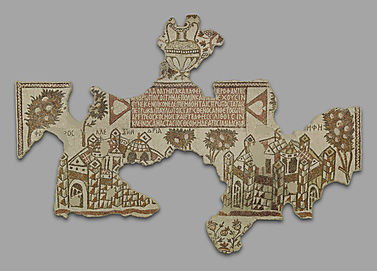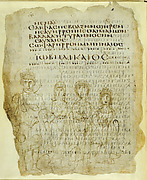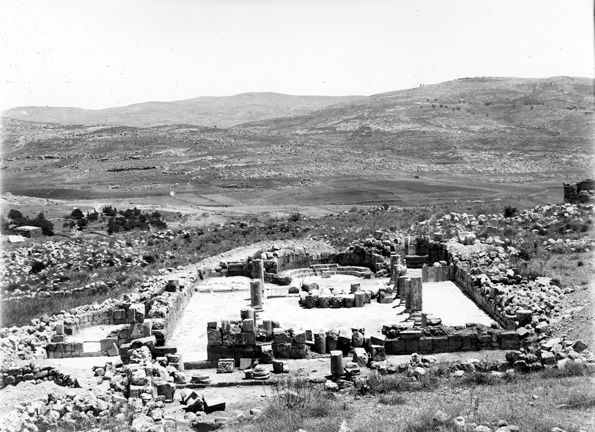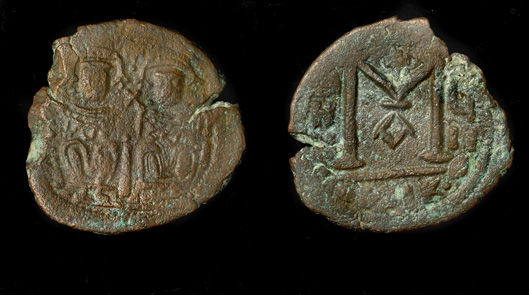Gerasa

Date: ca. 540
Medium: Limestone in ivory, dark ocher, beige, light gray, dark gray, and shades of red

Heraclius (r. 610–41), the most celebrated Byzantine emperor of the seventh century, suppressed the Sasanian Persian army’s advance on the Byzantine Empire’s southern provinces, reclaiming Jerusalem in 630, only to lose much of the territory to Arab advances during the final years of his reign. Under Heraclius, Greek replaced Latin as the official language of the state, signifying the importance of Byzantium’s southern territories. His efforts toward religious accommodation made him a hero in Islamic literature.
On this manuscript page, Job stands to the left in royal dress with his daughters. Job’s regained wealth and stature as described in the eponymous biblical book is emphasized by his contemporary Byzantine courtly costume. Similarities with images of Heraclius suggest that this depiction of Job may have been modeled on representations of the popular Byzantine emperor.
Annie Labatt, 2012 Chester Dale Fellow, Department of Medieval Art and The Cloisters

View of Via Antoninianus from the South Tetrapylon, Gerasa (Jerash), Jordan. Yale University Art Gallery, Gerasa Collection
One of the mosaics on view in the exhibition comes from the city of Gerasa (present-day Jerash, Jordan). Gerasa was an architecturally dense city founded during the second century B.C. Under Roman rule it included two theaters, two bath houses, a nymphaeum (public fountain), and a macellum (meat market).1 Although its prosperity diminished over time, by the third century A.D. the city had regained some of its wealth and reinstituted massive building campaigns. The original Roman temples, which had stopped being used, were not demolished. Thus new buildings, many of them Christian churches,2 added to the already architecturally dense fabric of the city, reducing the once large, straight streets to smaller byways.

Church of Saints Peter and Paul, Gerasa (Jerash), Jordan, in 1931. Yale University Art Gallery, Gerasa Collection
The source of Gerasa's wealth is not certain.3 Nevertheless, several objects from Gerasa, which are on view in the exhibition, indicate that commerce was certainly a major contributor to the city's prosperity. Examples include the seventh-century copper coins (shown below) and several oil lamps, whose dates suggest that Gerasa was still inhabited during the Umayyad period (from the seventh to the eighth centuries), even though it was once thought to have been deserted at that time.

http://www.metmuseum.org/exhibitions/objects?exhibitionId=%7b60853040-ae7e-4162-8fa7-525505d6b633%7d
Greek Fals of Gerasa, ca. 660–680. Copper. Byzantine Collection, Dumbarton Oaks, Washington, D.C. (BZC.2000.4.34)
Unlike other major cities in the region, such as Palmyra and Petra, Gerasa always retained a late-Hellenistic and Roman character underneath its multidimensional fabric.4 A synagogue built in 530–531, the occupation of the Persians in 614, and the rule under the Muslims after 635 all speak to a multicultural and vibrant cityscape—much like the one represented in the mosaic on view.
Date: ca. 540
Medium: Limestone in ivory, dark ocher, beige, light gray, dark gray, and shades of red
Floor Mosaic Depicting the Cities of Memphis and Alexandria, ca. 540. Yale University Art Gallery, New Haven, Excavated by the Yale–British School Archaeological Expedition, 1928–29 (1932.1735). Photograph courtesy of Christopher Gardner
Originally created for the floor of the Church of Saints Peter and Paul, this mosaic is a testament to the strong and vibrant presence of Christian communities in Gerasa during antiquity. Its dedicatory inscription points to the authority of the bishop Anastasios, and its representation of the cities of Memphis and Alexandria, in Egypt, suggests the Church's oversight of even the most powerful of cities of the day. As the inscription emphasizes, it is Anastasios, not the cities, that provide "beautiful marvels to the people who inhabit this city and land."
fonte: @edisonmariotti #edisonmariotti http://www.metmuseum.org/exhibitions/listings/2012/byzantium-and-islam/blog/where-in-the-world/posts/gerasa


Nenhum comentário:
Postar um comentário